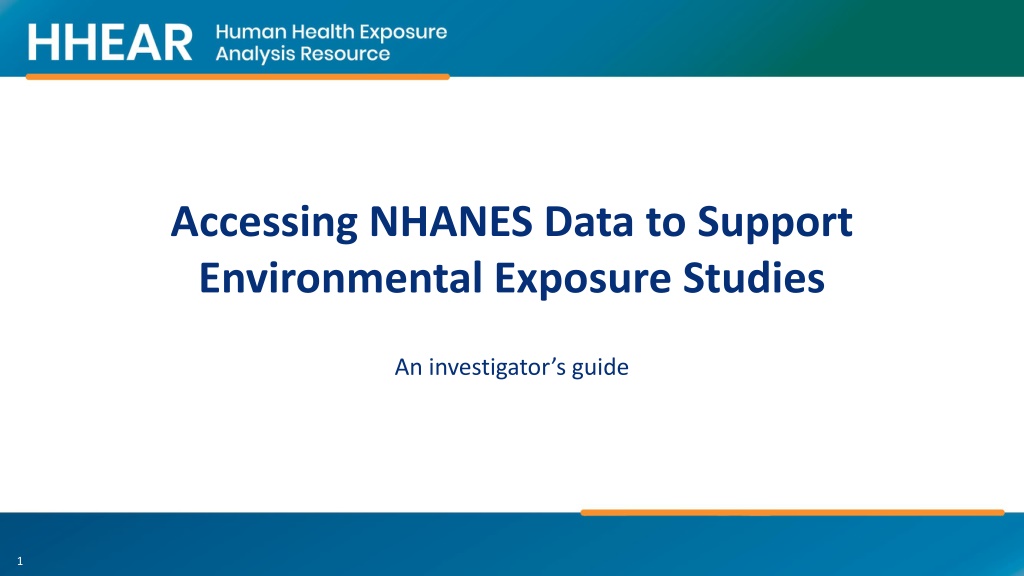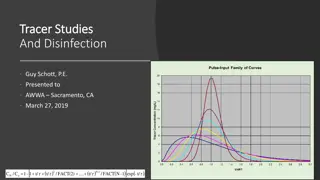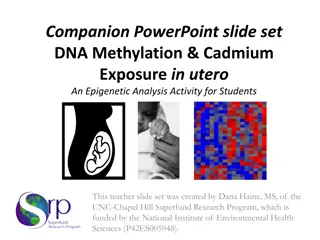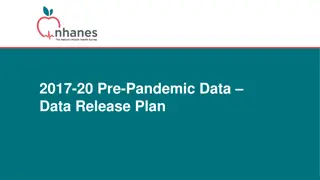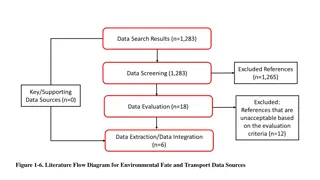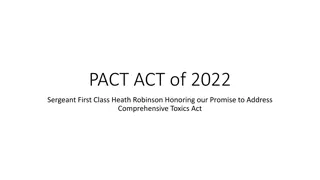Understanding NHANES Data for Environmental Exposure Studies
National Health and Nutrition Examination Survey (NHANES) is a crucial population-based survey in the U.S. that collects data on health and nutritional status. This data supports various applications, including assessing human exposure to environmental chemicals. NHANES conducts biomonitoring to quantify exposure trends, providing valuable insights for public health research and decision-making. The National Report on Human Exposure to Environmental Chemicals offers comprehensive data from 1999-2018 for analysis and prevention strategies. The report aids in identifying exposure risks, establishing reference ranges, and evaluating the effectiveness of public health interventions.
Download Presentation

Please find below an Image/Link to download the presentation.
The content on the website is provided AS IS for your information and personal use only. It may not be sold, licensed, or shared on other websites without obtaining consent from the author. Download presentation by click this link. If you encounter any issues during the download, it is possible that the publisher has removed the file from their server.
E N D
Presentation Transcript
Accessing NHANES Data to Support Environmental Exposure Studies An investigator s guide 1
Objectives Understand what the National Health and Nutrition Examination Survey (NHANES) is and what types of data it contains. Understand how NHANES data can support HHEAR applications Be able to access NHANES data 2
About NHANES (1 of 2) The National Health and Nutrition Examination Survey (NHANES) is a population-based survey of the U.S. population. NHANES collects data on the health and nutritional status of the U.S. population. Biomonitoring measurements use samples from NHANES participants In 1999, NHANES became a continuous survey, sampling the U.S. population annually and releasing the data in 2-year cycles. To select a representative sample of the civilian, noninstitutionalized population, sampling follows a complex, stratified, multistage, probability- cluster design based on age, gender, and race/ethnicity. Source: https://www.cdc.gov/nchs/nhanes/index.htm 3
About NHANES (2 of 2) The NHANES conducts the quantification of exposure and captures long-term trends of known exposures across the U.S. population. Chemicals of potential concern (e.g., arsenic, environmental phenols) continue to be added to NHANES, with the most recent report on environmental exposure including data on more than 400 chemicals. Source: https://www.cdc.gov/exposurereport/ 4
National Report on Human Exposure to Environmental Chemicals The result of NHANES biomonitoring is a National Report on Human Exposure to Environmental Chemicals Currently, this customizable report contains nationally representative and cumulative biomonitoring data from 1999-2000 through 2017-2018 Includes individual and pooled blood or urine samples The data are informative regarding prevalence data on disease trends, though they are not able to provide assessment of disease exposure associations 5
Public Health Uses of the Report The overall purpose of the National Report on Human Exposure to Environmental Chemicals is to provide specific information to scientists, physicians, and health officials to help prevent exposure to environmental chemicals. Example public health uses of the exposure information in the Report include the following: To determine chemicals and concentrations getting into U.S. residents To determine the prevalence of people with levels of chemicals above known toxicity levels To establish reference ranges E.g., helps identify population groups that merit further assessment of exposure sources or health effects To assess the effectiveness of public health efforts to reduce exposure to specific chemicals To track trends in levels of exposure of the population To set priorities for research on human health effects Source: https://www.cdc.gov/exposurereport/overview_ner.html 6
How NHANES Data Can Support HHEAR Applications (1 of 2) HHEAR provides services for analysis of human and environmental samples from human health studies to measure environmental exposures *Note that at this time, NHANES does not include data collected from environmental samples (e.g. air, water, dust) NHANES biomonitoring data can be used to complement proposed HHEAR studies by providing information regarding population exposures 7
How NHANES Data Can Support HHEAR Applications (2 of 2) Example of NHANES biomonitoring data Demographic categories Total population Ages 6+ in survey years 11-12 and 13-14 Ages 3+ in survey years 15-16 Age 3-5 years Age 6-11 years Age 12-19 years Age 20+ years Males Females Mexican Americans Non-Hispanic Blacks Non-Hispanic Whites All Hispanics Asians 8
How NHANES Data Can Support HHEAR Applications NHANES data can provide guidance on what are emerging contaminants in populations as well as legacy contaminants and can subsequently support understanding of feasibility of proposed studies 9
Guidance for what to look for in NHANES data (1 of 2) Is NHANES detecting a compound of interest in your cohort during the year(s) of biospecimen collection? If yes, when did NHANES start detecting the compound? And when was the last date of assessment? 10
Guidance for what to look for in NHANES data (2 of 2) Is there evidence of a temporal trend? E.g., Were concentrations of the compound higher in specimens from 1999 than 2008? How does that compare to 2016? Consider this in context with what years biospecimens were collected from your cohort. Consider the NHANES or subgroup comparability to your cohort. 11
Example 1: Using NHANES Data to Support Evaluations (1 of 2) Source: https://doi.org/10.3390/ijerph18073730 Utilizing NHANES data on PFAS to study exposure among volunteer firefighters Researchers compared their study participants PFAS distribution and serum levels to the NHANES data among non-Hispanic white adult male participants in the 2015-2016 and 2017-2018 NHANES survey cycles 12
Example 1: Using NHANES Data to Support Evaluations (2 of 2) Compared with NHANES, serum levels of PFNA, PFDA, and PFDoA, were elevated in male, volunteer firefighters Source: Graber et al. 2021. Int. J. Environ. Res. Public Health 13
Example 2: Using NHANES Data to Support Evaluations (1 of 5) Environmental metals and chemicals and COPD Urinary metals PAH compounds Arsenic species Source: https://doi.org/10.1007/s11356-022-19695-w 14
Example 2: Using NHANES Data to Support Evaluations (2 of 5) Summary statistics for demographics related to COPD Source: Rahman et al. 2022. Environ Sci Pollut Res Int 15
Example 2: Using NHANES Data to Support Evaluations (3 of 5) Dose response plots of participants with COPD for 14 urinary metals Source: Rahman et al. 2022. Environ Sci Pollut Res Int 16
Example 2: Using NHANES Data to Support Evaluations (4 of 5) Dose response plots of participants with COPD for seven forms of PAH Source: Rahman et al. 2022. Environ Sci Pollut Res Int 17
Example 2: Using NHANES Data to Support Evaluations (5 of 5) Dose response plots of participants with COPD for seven forms of speciated arsenic Source: Rahman et al. 2022. Environ Sci Pollut Res Int 18
Guidance for what to look for in NHANES data Additional points to consider when using NHANES data: What is the level of detection for each compound of interest? Has the LOD method changed over time? NHANES data can provide guidance as to what exposures of interest may be most appropriate for an investigator s cohort Note: for more information on Environmental Exposures, see HHEAR s Environmental Exposures module 19
Accessing NHANES Biomonitoring Data Tables (1 of 6) The National Report on Human Exposure to Environmental Chemicals is accessible on the CDC website: https://www.cdc.gov/exposurereport/ 20
Accessing NHANES Biomonitoring Data Tables (2 of 6) Source: https://www.cdc.gov/exposurereport/ 21
Accessing NHANES Biomonitoring Data Tables (3 of 6) To access the biomonitoring data tables, click on the Biomonitoring data tables for environmental chemicals image or visit: https://www.cdc.gov/exposurereport/data_tables.html 22
Accessing NHANES Biomonitoring Data Tables (4 of 6) Source: https://www.cdc.gov/exposurereport/data_tables.html 23
Accessing NHANES Biomonitoring Data Tables (5 of 6) Source: https://www.cdc.gov/exposurereport/data_tables.html 24
Accessing NHANES Biomonitoring Data Tables (6 of 6) Source: https://www.cdc.gov/exposurereport/data_tables.html 25
Resources Interested in utilizing NHANES as a resource to support your HHEAR application, but still feel like you need more guidance? Contact the HHEAR Coordinating Center at HHEARHelp@westat.com to request a pre- submission consultation hhearprogram.org 26
Additional Resources About the National Biomonitoring Program: https://www.cdc.gov/biomonitoring/about.html National Report on Human Exposure to Environmental Chemicals: https://www.cdc.gov/exposurereport/ Biomonitoring Data Tables for Environmental Chemicals: https://www.cdc.gov/exposurereport/data_tables.html?NER_SectionItem =NHANES Data Table Viewer User Guide: https://www.cdc.gov/exposurereport/pdf/user_guide.pdf 27
